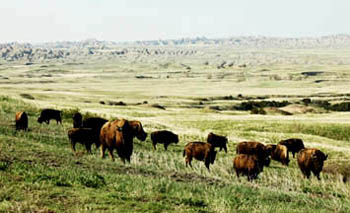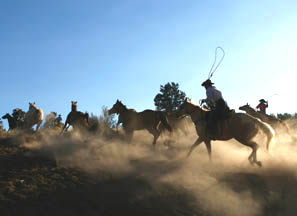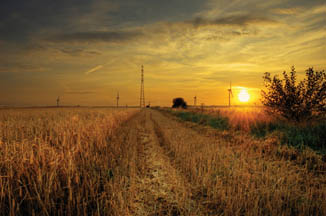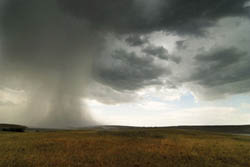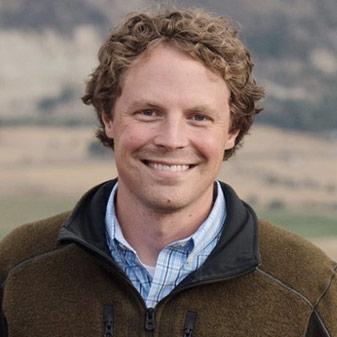At the end of the 19th century, historians declared that the American frontier had closed. The Homestead Act had caused population density in the West to exceed two people per square mile—the metric the census used to gauge frontier status. Writing in 1893, historian Frederick Jackson Turner regretted the impact this would have on the character of the American individual. The frontier, he claimed, created freedom by “breaking the bonds of custom, offering new experiences, [and] calling out new institutions and activities.” According to Turner, with the closing of the frontier went the American propensity to forge new ideas, institutions, and solutions in the face of new environments.
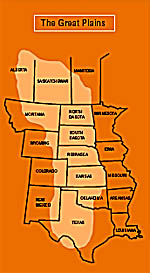
Without a doubt, the plains are undergoing a period of economic and demographic change—agriculture provides only half as much employment and income to the region as it did in 1969—but where some see the death of a traditional way of life, others see a landscape full of new opportunities. Land values are rising and nonlocals are buying up property for investment or recreational purposes. Entrepreneurs are creating new enterprises by capitalizing on ecotourism and the preservation of environmental amenities, thus transforming the region’s traditional agriculture-rangeland paradigm into a new nature-based economy.
Without a doubt, the plains are undergoing a period of economic and demographic change, but where some see the death of a traditional way of life, others see a landscape full of new opportunities.
Hidden in this dynamic process of change is an irony: population density outside of metropolitan areas in the Great Plains has fallen to 1.5 people per square mile—well below frontier density. The frontier that Turner saw as the engine for new institutions and innovations has returned. What’s emerging is a new type of region—one that is led by entrepreneurs discovering innovative ways of combining traditional land management with new opportunities on the frontier.
Old West Meets New West
“Move ’em out!” On a warm July morning, Jim Collins, a rancher in Montana’s Powder River County, gave out the traditional yell that marks the beginning of the annual Powder River Cattle Drive. The event usually hosts 60 paying guests and involves up to 50 local ranchers. At $2,200 per person, guests are provided horses and wagon teams for the six-day trip.
On that same morning, Bryce Christensen, manager of the privately funded American Prairie Reserve, got in his pickup to begin a day’s work on the property. The 121,000-acre Reserve, located on the northern edge of Montana’s Charles M. Russell National Wildlife Refuge, is dedicated to wildlife preservation. All together, 14,000 acres are fenced and devoted to bison. The Reserve leases the other 107,000 acres to nearby livestock owners who use the land for traditional ranching operations, but do so by utilizing moderate grazing—a measure that assures the integrity of the Reserve’s wildlife habitat.
Similar activity occurs on many newly purchased ranches in eastern Montana and western North and South Dakota, where hunters have bought ranches to secure access to good deer and antelope hunting. In most cases, these ranches are leased to local ranch owners for livestock grazing but with certain constraints, such as the maintenance of brush for deer cover.
Across the Great Plains, entrepreneurial arrangements such as these between traditional land users and a growing nature-based economy are unfolding, creating new experiences, institutions, and activities in the same way that Turner described the frontier. Northwest Nebraska High Country, a group of more than 20 local farmers and ranchers, offers lodging, hunting, and recreation on its land in the scenic Pine Ridge region of Nebraska. Similarly, ranches in South Dakota are providing exclusive pheasant hunting operations—an activity that has generated record numbers of out-of-state hunters and delivered a $153 million boost to its economy.
The frontier that Turner saw as the engine for new institutions and innovations has returned. What ’ s
emerging is a new type of region—one that is led by entrepreneurs.
Save the Plains?
Many journalistic depictions of the region have implied an urgent sense of hopelessness throughout the plains, requiring large-scale government intervention and economic revitalization. Senator Byron Dorgan of North Dakota has repeatedly pushed for a New Homestead Act, which proposes the repayment of college loans for graduates who locate in high out-migration counties, the creation of a $3 billion venture capital fund, and generous tax credits for businesses willing to locate in rural counties. At the state level, Montana, North Dakota, and South Dakota each have state-funded economic development agencies, where most of the focus is on providing assistance to the areas where out-migration is occurring.
The problem with these top-down efforts to save the plains is that they ignore a basic economic reality: it is on-the-ground entrepreneurs who have the time and place-specific information to adequately adjust to the changes that are taking place in the region. Local landowners like the Switzer family in Nebraska are better positioned to make the best use of their ranch. By altering their cattle operation to provide a greater diversity of bird habitat, they, along with their neighbors, have created the first privately owned site to be awarded Important Bird Area Status from the Nebraska Audubon Society, increasing returns to their operation and the environment.
Nonprofit groups such as the American Prairie Foundation are also localized agents of change. Guided by the incentives of private ownership, these groups achieve their ends of preserving wildlife habitat by finding the most cost-effective ways to adjust traditional agriculture operations and by engaging in voluntary exchanges with local landowners. For instance, the Nature Conservancy has purchased 6,000 acres on the edge of Badlands National Park and secured control of an additional 20,000 acres of federal grazing allotments. These areas are used to benefit the endangered black-footed ferret as well as to allow modest grazing activity to continue.
It is on-the-ground entrepreneurs who have the time – and place – specific information to adequately adjust to the changes that are taking place in the region.
What’s happening in the Great Plains is being replicated in many other parts of the West, where traditional agricultural activities are adapting to provide more environmental amenities. The important players in the adjustment process are entrepreneurs with local knowledge and with the incentives to get the right mix of traditional and nontraditional activities. Success in maintaining economic viability in this region depends on these entrepreneurs.
Where the Buffalo Roam
In 1987, two New Jersey academics cast their vision for the future of the Great Plains. Frank and Deborah Popper claimed that the settlement of this region was “the longest-running agricultural and environmental miscalculation in American history” and advocated, instead, the creation of a “Buffalo Commons.” Under their plan, the plains would “be restored to its pre-white state” and “in effect, deprivatized.” Buffalo would freely roam as the plains became “almost totally depopulated” over the next generation.
To many, their prediction has turned out to be remarkably prescient. The plains have gradually depopulated and a quarter of a million buffalo now roam throughout the West. So, was the Poppers’ vision of a “Buffalo Commons” correct? In a sense, it was. The Poppers forecasted a region undergoing dramatic economic and social change—a claim that has undoubtedly been borne out in recent decades.
The Poppers, however, were wrong about how change would occur. In fact, they neglected their own words: “A new use for the region will emerge,” they wrote in 1987. And that’s precisely what’s happening; local solutions are emerging from entrepreneurs. If bison are to roam throughout the Great Plains, it shouldn’t be because planners mandated it, but because people on the ground find it most effective given alternative choices. In fact this is already happening. The bison that exist on the plains are largely the result of entrepreneurs creating markets for the animals and demonstrating that new ways of thinking about the plains are alive and well.
If bison are to roam throughout the Great Plains, it shouldn’t be because planners mandated it, but because people on the ground find it most effective given alternative choices.
In the spirit of Frederick Jackson Turner’s frontier, the new emergent order on the plains is “breaking the bonds of custom, offering new experiences, [and] calling out new institutions and activities,” and it is the job of the entrepreneur to harness these new opportunities on the Great Plains. As for the economic planners touting top-down solutions to save the plains? They’d do the Great Plains a favor by getting out of the way.
